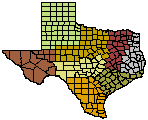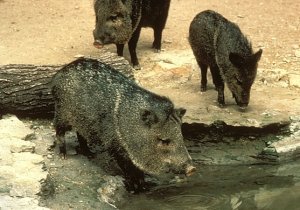- Trans Pecos
- High Plains/Panhandle
- Cross Timbers
- Hill Country
- Post Oak Savannah
- Pineywoods
- Oak Prairie
- South Texas Plains

Wildlife Division District Map
Javelina

Javelina are members of the peccary family. There are actually three species of peccaries that range from the Southwestern United States south to central South America. The only species found in the United States is the collared peccary, or javelina. In Texas, the javelina is found in the more arid or semi-arid parts of the state, with most occurring in the South Texas brush country, the Trans-Pecos' desert grasslands, and the Edwards Plateau's oak-juniper woodlands.
Javelina travel in small herds or "family groups" and seem to have a somewhat limited home range. In the winter, they are generally active in the early morning and late afternoon. Javelina are largely nocturnal during the hotter times of the year. They feed primarily on cacti (particularly prickly pear), mesquite beans, lechuguilla, sotol, mast, fruits, and insects.
Javelina have long held an undeserved reputation for ferocity. They have poor eyesight and will often remain around humans longer than other wildlife when startled. When cornered, they can defend themselves very effectively with sharp canine teeth or "tusks". Many dogs have been crippled or killed when trying to attack javelina. Yet aggressive encounters with humans are very, very rare. , javelina can be very troublesome to landowners when they become habituated to homes and human activities. They often sleep in caves, and cave like areas, and seem to find the crawl spaces under homes attractive. They may cause significant damage to yards and sprinkler systems because of their habit of rooting for food.
In Texas, javelina are classified as a game animal and may be legally harvested with a hunting license, during hunting season, in counties which have a season. However, local ordinances often prohibit the discharging of a firearm within city limits. Thus the methods described here are usually preferred over the killing of problem animals.
Problem Javelina Management
As the population of Texas continues to grow, many people are rediscovering the rural countryside as a picturesque and peaceful site to reside. While country living often provides a fantastic opportunity to view some of the state's wildlife , it can also pose problems when this wildlife comes into conflict with the activities of home owners. Interactions between people and species such as deer, coyotes, skunks, raccoons, turkey, and javelina continue to increase as development expands into previously unoccupied areas. One of the most least understood, and often feared animals that individuals come into contact with is the javelina.
One of the primary reasons people have problems with javelina is because they intentionally feed them. Soon they become accustomed to humans and may eventually become dangerous. Never deliberately feed javelina!
Similarly, access to unintentional food sources such as garbage, pet food, some flowering plants, bird seed, and fruit from trees should be minimized. All garbage should be stored securely. Pets should be fed indoors or, if fed outside, the pet owner should completely remove all left over food immediately.
Some flowering plants, such as tulips produce a bulb that javelina find very tasty. Often poultry wire placed right at, or below the surface can protect gardens or flower beds. Grubs that are frequently found in gardens and manure also attract javelina. Fruit from trees should be picked up as soon as possible or fenced effectively.
If total exclosure is desired or poultry wire proves insufficient, a low voltage electric fence is very effective. Generally, a single strand of wire ran 5 to 10 inches above the ground will completely exclude javelina from a particular area.
Larger landowners are often concerned about javelina damaging net wire fences. In these situations, landowners may "peg" holes under fences to avoid the need for javelina to create more holes. Javelina will generally use existing openings rather than creating new ones.
Other hints to avoid javelina problems include closing off all opening to spaces under buildings. Dogs should not be allowed to run loose or be left tied up where javelina can have access to them. Any low growing shrubbery that may provide cover should be avoided or trimmed from the ground up.
When javelina are encountered around your home, attempt to scare them off by making loud noises and throwing rocks. Inform your neighbors of these guidelines. It is often necessary for every individual in a neighborhood to make an effort in order to completely prevent javelina problems.